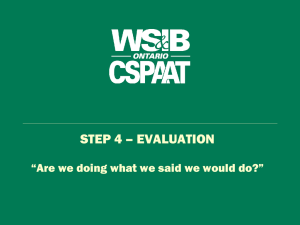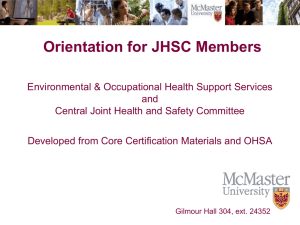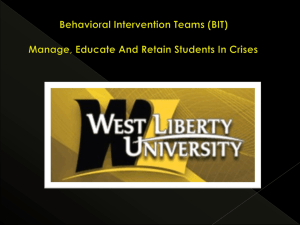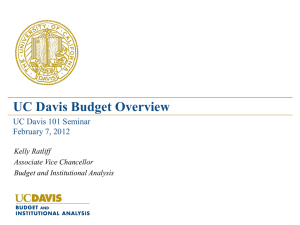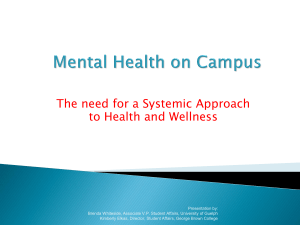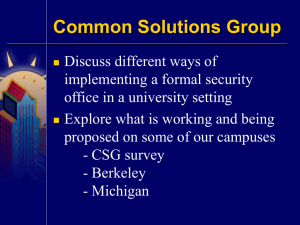Safety Committee-Best Practices - Minnesota State Colleges and
advertisement
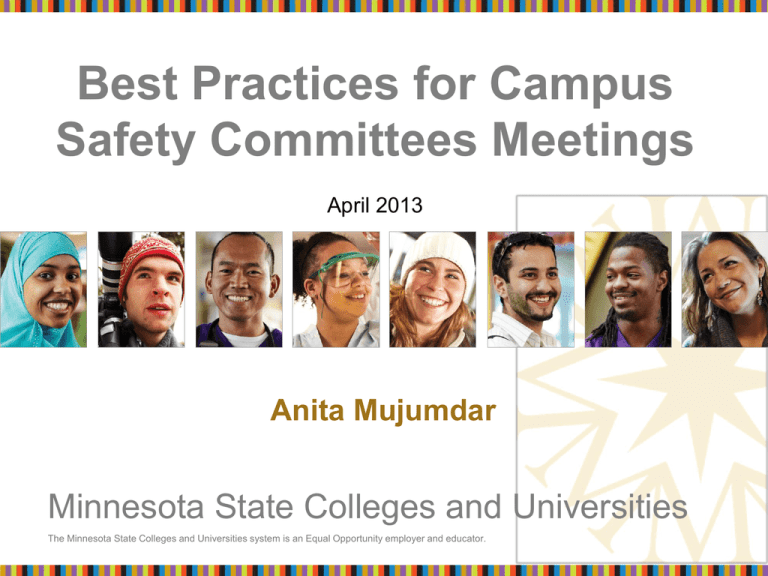
Best Practices for Campus Safety Committees Meetings April 2013 Anita Mujumdar Minnesota State Colleges and Universities The Minnesota State Colleges and Universities system is an Equal Opportunity employer and educator. Agenda Campus Safety Committee requirements Statutory requirements Collective Bargaining Unit requirements Joint Health and Safety Committees (JHSC) Best Practices for meetings Mission Statement Committee Composition Meeting frequency Agenda, employee involvement, etc. Workplace Safety Inspections Summary 2 Campus Safety Committee: Statutory Requirement All colleges and universities are required to have a labor/management safety committee. MN State Statute 182.676 (a): Requires every public or private employer of more than 25 employees shall establish and administer a joint labor-management safety committee. Safety Committee 3 to perform workplace inspections, review injury and illness records, make advisory recommendations to management and perform other functions. Campus Safety Committee: AFSCME Contract Requirement Specific requirements in AFSCME collective bargaining agreement, Article 11, Section 2 Campus must conduct at least quarterly meetings One representative from each bargaining unit represented by a Union At a minimum two (2) representatives 4 Campus Safety Committee: AFSCME Contract Requirement (cont’d) • Safety committee member or local union officer can participate in safety inspection conducted by safety committee or EHS personnel • Safety inspection to be conducted at least yearly • Copy of meeting minutes to be send to System Office 5 Best Practices for Joint Health and Safety Committees • Mission or Statement of Purpose The role of JHSC has to be transparent and well defined Develop a clear, univocal commitment to employee health and safety Inform all campus employees of JHSC’s mission by posting on bulletin board or through email memo. Committee Composition Should be large enough to ensure fair representation of all bargaining units and management but small enough to be able to get things done 6 Best Practices for Joint Health and Safety Committees • Committee composition Ensure adequate AFSCME and student representation and alternates for each member For employees to be on the committee, the most important criteria are interest and concern about workplace health and safety Ensure the all campus employee are aware of the JHSC meetings and members The committee members need to have adequate time and support to work on committee functions 7 Important to include management members or have support to implement committee recommendations Best Practices for Meetings • Plan on frequent meetings Schedule regular (monthly) safety meetings Schedule meeting at same time and day of month, same room etc. Develop meeting schedule for the entire year and inform JHSC and all campus employees Conduct scheduled meetings while strictly observing start and stop time Encourage 100% member attendance (or their substitutes) 8 Best Practices: Agenda Agenda to be prepared and distributed well in advance of each scheduled meeting Ensure that meetings take place in an atmosphere of mutual respect and commitment to health and safety Follow a standard agenda for each meeting Conduct roll call in every meeting Approval of meeting minutes Assign responsibilities to members Member conducting meeting Member recording minutes Ensure meeting minutes are recorded effectively 9 Best Practices: Agenda (Cont’d) Agenda Address the injuries, illness, incidents and near misses in each meeting Employee injuries and student injuries addressed as separate items A specific time period (10 or 15 minutes) be assigned to each agenda item Meetings should not be used as a forum for airing general complaints and grievances Suggested AFSCME agenda (Appendix A) 10 Best Practices Meeting Minutes – follow a standard format Time and date of meeting, who attended Items discussed (reports, problems, education…) Specific recommendations and reasons for them Time and date of next meeting Management Support Ensure there is adequate management support for JHSC activities Ensure that the committee recommendations are generally implemented or management provides reasons for not implementing them 11 Best Practices Employee Involvement Use a hazard reporting procedure (Appendix I) to encourage all campus employees for reporting hazards Encourage employees to communicate unresolved issues to the JHSC Inform all campus employees of JHSC mission, work and meetings Use bulletin boards, forums, emails or memos to post names and contact information of committee members, minutes and other important information Ensure the employees perceive JHSC as performing a useful and active function 12 Work Place Safety Inspections JHSC Committee Schedule and conduct annual workplace safety inspections Designate sub-committee to conduct assigned inspections according to campus configuration (buildings, areas or programs) Report findings to the committee (Walkthrough Inspection Worksheet – Appendix II) Ensure the recommendations are implemented 13 Summary • Effective JHSC interacts frequently with all campus employees • Safety is the responsibility of each and every employee • All MnSCU campuses have JHSCs • Standardization for safety meetings and reporting o Will help evaluate progress and o Enable us to develop and provide targeted resources 14 Questions 15
